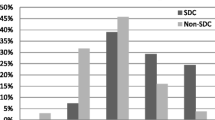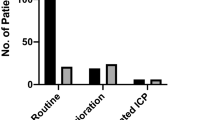Abstract
Background
Intracranial pressure (ICP) monitoring represents an important tool in the management of traumatic brain injury (TBI). Although current information exists regarding ICP monitoring in secondary decompressive craniectomy (DC), little is known after primary DC following emergency hematoma evacuation.
Methods
Retrospective analysis of prospectively collected data. Inclusion criteria were age ≥18 years and admission to the intensive care unit (ICU) for TBI and ICP monitoring after primary DC. Exclusion criteria were ICU length of stay (LOS) <1 day and pregnancy. Major objectives were: (1) to analyze changes in ICP/cerebral perfusion pressure (CPP) after primary DC, (2) to evaluate the relationship between ICP/CPP and neurological outcome and (3) to characterize and evaluate ICP-driven therapies after DC.
Results
A total of 34 patients were enrolled. Over 308 days of ICP/CPP monitoring, 130 days with at least one episode of intracranial hypertension (26 patients, 76.5%) and 57 days with at least one episode of CPP <60 mmHg (22 patients, 64.7%) were recorded. A statistically significant relationship was discovered between the Glasgow Outcome Scale (GOS) scores and mean post-decompression ICP (p < 0.04) and between GOS and CPP minimum (CPPmin) (p < 0.04). After DC, persisting intracranial hypertension was treated with: barbiturate coma (n = 7, 20.6%), external ventricular drain (EVD) (n = 4, 11.8%), DC diameter widening (n = 1, 2.9%) and removal of newly formed hematomas (n = 3, 8.8%).
Conclusion
Intracranial hypertension and/or low CPP occurs frequently after primary DC; their occurence is associated with an unfavorable neurological outcome. ICP monitoring appears useful in guiding therapy after primary DC.







Similar content being viewed by others
References
Aarabi B, Hesdorffer DC, Ahn ES, Aresco C, Scalea TM, Eisenberg HM (2006) Outcome following decompressive craniectomy for malignant swelling due to severe head injury. J Neurosurg 104(4):469–479
Baker SP, O’Neill B, Haddon W Jr, Long WB (1974) The injury severity score: a method for describing patients with multiple injuries and evaluating emergency care. J Trauma 14(3):187–196
Brain Trauma Foundation, American Association of Neurological Surgeons (AANS), Congress of Neurological Surgeons (CNS), AANS/CNS Join Section on Neurotrauma and Critical Care (2007) Guidelines for the management of severe traumatic brain injury, 3rd edition. J Neurotrauma 24(suppl 1):S1–S106
Carney N, Totten AM, OʼReilly C, Ullman JS, Hawryluk GW, Bell MJ, Bratton SL, Chesnut R, Harris OA, Kissoon N, Rubiano AM, Shutter L, Tasker RC, Vavilala MS, Wilberger J, Wright DW, Ghajar J (2016) Guidelines for the management of severe traumatic brain injury, Fourth Edition. Neurosurgery. doi:10.1227/NEU.0000000000001432
Chesnut RM (2015) A conceptual approach to managing severe traumatic brain injury in a time of uncertainty. Ann N Y Acad Sci 1345:99–107
Chesnut RM (2015) What is wrong with the tenets underpinning current management of severe traumatic brain injury? Ann N Y Acad Sci 1345:74–82
Chesnut RM, Bleck TP, Citerio G, Classen J, Cooper DJ, Coplin WM, Diringer MN, Grände PO, Hemphill JC 3rd, Hutchinson PJ, Le Roux P, Mayer SA, Menon DK, Myburgh JA, Okonkwo DO, Robertson CS, Sahuquillo J, Stocchetti N, Sung G, Temkin N, Vespa PM, Videtta W, Yonas H (2015) A consensus-based interpretation of the benchmark evidence from South American trials: treatment of intracranial pressure trial. J Neurotrauma 32(22):1722–1724
Chesnut RM, Temkin N, Carney N, Dikmen S, Rondina C, Videtta W, Petroni G, Lujan S, Pridgeon J, Barber J, Machamer J, Chaddock K, Celix JM, Cherner M, Hendrix T, Global Neurotrauma Research Group (2012) A trial of intracranial-pressure monitoring in traumatic brain injury. N Engl J Med 367(26):2471–2481
Chesnut R, Videtta W, Vespa P, Le Roux P, Participants in the International Multidisciplinary Consensus Conference on Multimodality Monitoring (2014) Intracranial pressure monitoring: fundamental considerations and rationale for monitoring. Neurocrit Care 21(Suppl 2):S64–S84
Cooper DJ, Rosenfeld JV, Murray L, Arabi YM, Davies AR, D’Urso P, Kossmann T, Ponsford J, Seppelt I, Reilly P, Wolfe R, DECRA Trial Investigators; Australian and New Zealand Intensive Care Society Clinical Trials Group (2011) Decompressive craniectomy in diffuse traumatic brain injury. N Engl J Med 364(16):1493–1502
Cremer OL, van Dijk GW, van Wensen E, Brekelmans GJ, Moons KG, Leenen LP, Kalkman CJ (2005) Effect of intracranial pressure monitoring and targeted intensive care on functional outcome after severe head injury. Crit Care Med 33(10):2207–2213
Flint AC, Manley GT, Gean AD, Hemphill JC 3rd, Rosenthal G (2008) Post-operative expansion of hemorrhagic contusions after unilateral decompressive hemicraniectomy in severe traumatic brain injury. J Neurotrauma 25:503–512
Güiza F, Depreitere B, Piper I, Citerio G, Chambers I, Jones PA, Lo TY, Enblad P, Nillson P, Feyen B, Jorens P, Maas A, Schuhmann MU, Donald R, Moss L, Van den Berghe G, Meyfroidt G (2015) Visualizing the pressure and time burden of intracranial hypertension in adult and paediatric traumatic brain injury. Intensive Care Med 41(6):1067–1076
Hamilton R, Xu P, Asgari S, Kasprowicz M, Vespa P, Bergsneider M, Hu X (2009) Forecasting intracranial pressure elevation using pulse waveform morphology. Conf Proc IEEE Eng Med Biol Soc 2009:4331–4334
Hu X, Xu P, Scalzo F, Vespa P, Bergsneider M (2009) Morphological clustering and analysis of continuous intracranial pressure. IEEE Trans Biomed Eng 56(3):696–705
Huang YH, Lee TC, Lee TH, Yang KY, Liao CC (2013) Remote epidural hemorrhage after unilateral decompressive hemicraniectomy in brain-injured patients. J Neurotrauma 30:96–101
Huang YH, Ou CY (2016) Prognostic impact of intracranial pressure monitoring after primary decompressive craniectomy for traumatic brain injury. World Neurosurg 88:59–63
Jennett B, Bond M (1975) Assessment of outcome after severe brain damage. Lancet 1(7905):480–484
Kolias AG, Kirkpatrick PJ, Hutchinson PJ (2013) Decompressive craniectomy: past, present and future. Nat Rev Neurol 9(7):405–415
Le Gall JR, Lemeshow S, Saulnier F (1993) A new Simplified Acute Physiology Score (SAPS II) based on a European/North American multicenter study. JAMA 270(24):2957–2963
Maas AI, Hukkelhoven CW, Marshall LF, Steyerberg EW (2005) Prediction of outcome in traumatic brain injury with computed tomographic characteristics: a comparison between the computed tomographic classification and combinations of computed tomographic predictors. Neurosurgery 57(6):1173–1182
Maas AI, Stocchetti N, Bullock R (2008) Moderate and severe traumatic brain injury in adults. Lancet Neurol 7(8):728–741
Marmarou A, Eisenberg HM, Foulkes MA, Marshall LF, Jane JA (1991) Impact of ICP instability and hypotension on outcome in patients with severe head trauma. J Neurosurg 75(1S):S59–S66
Olivecrona M, Rodling-Wahlström M, Naredi S, Koskinen LO (2007) Effective ICP reduction by decompressive craniectomy in patients with severe traumatic brain injury treated by an ICP-targeted therapy. J Neurotrauma 24(6):927–935
Rangel-Castilla L, Gasco J, Nauta HJ, Okonkwo DO, Robertson CS (2008) Cerebral pressure autoregulation in traumatic brain injury. Neurosurg Focus 25(4):E7
Roozenbeek B, Maas AI, Menon DK (2013) Changing patterns in the epidemiology of traumatic brain injury. Nat Rev Neurol 9(4):231–236
Servadei F, Compagnone C, Sahuquillo J (2007) The role of surgery in traumatic brain injury. Curr Opin Crit Care 13(2):163–168
Shafi S, Diaz-Arrastia R, Madden C, Gentilello L (2008) Intracranial pressure monitoring in brain-injured patients is associated with worsening of survival. J Trauma 64(2):335–340
Stiver SI (2009) Complications of decompressive craniectomy for traumatic brain injury. Neurosurg Focus 26(6):E7
Stocchetti N, Maas AI (2014) Traumatic intracranial hypertension. N Engl J Med 370(22):2121–2130
Stocchetti N, Picetti E, Berardino M, Buki A, Chesnut RM, Fountas KN, Horn P, Hutchinson PJ, Iaccarino C, Kolias AG, Koskinen LO, Latronico N, Maas AI, Payen JF, Rosenthal G, Sahuquillo J, Signoretti S, Soustiel JF, Servadei F (2014) Clinical applications of intracranial pressure monitoring in traumatic brain injury: report of the Milan Consensus Conference. Acta Neurochir (Wien) 156(8):1615–1622
Stocchetti N, Zanaboni C, Colombo A, Citerio G, Beretta L, Ghisoni L, Zanier ER, Canavesi K (2008) Refractory intracranial hypertension and “second-tier” therapies in traumatic brain injury. Intensive Care Med 34(3):461–467
Teasdale G, Jennett B (1974) Assessment of coma and impaired consciousness. A practical scale. Lancet 2(7872):81–84
Vik A, Nag T, Fredriksli OA, Skandsen T, Moen KG, Schirmer-Mikalsen K, Manley GT (2008) Relationship of “dose” of intracranial hypertension to outcome in severe traumatic brain injury. J Neurosurg 109(4):678–684
Zeng J, Tong W, Zheng P (2013) Decreased risk of acute kidney injury with intracranial pressure monitoring in patients with moderate or severe brain injury. J Neurosurg 119(5):1228–1232
Acknowledgements
We would like to thank Mario Mergoni, MD, and Tracy K. McIntosh, PhD, for their valuable suggestions.
Author information
Authors and Affiliations
Corresponding author
Ethics declarations
Funding
No funding was received for this research.
Conflicts of interest
None.
Ethical approval
All procedures performed in studies involving human participants were in accordance with the ethical standards of the institutional and/or national research committee and with the 1964 Helsinki Declaration and its later amendments or comparable ethical standards.
For this type of study formal consent is not required.
Rights and permissions
About this article
Cite this article
Picetti, E., Caspani, M.L., Iaccarino, C. et al. Intracranial pressure monitoring after primary decompressive craniectomy in traumatic brain injury: a clinical study. Acta Neurochir 159, 615–622 (2017). https://doi.org/10.1007/s00701-017-3118-z
Received:
Accepted:
Published:
Issue Date:
DOI: https://doi.org/10.1007/s00701-017-3118-z




